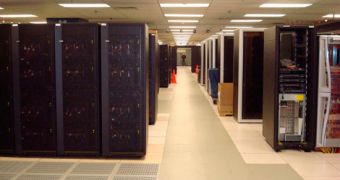Scientists from Iowa State University are going to be part of a giant consortium involved in the development of the most powerful supercomputer in the world. The new device, which will be located at the National Center for Supercomputing Applications (NCSA) at the University of Illinois, will be able to perform a sustained rate of a quadrillion calculations per second (that's 1.000.000.000.000.000/s).
The National Science Foundation is granting the "petaflop" (that's what that kind of speed is called) supercomputer project $208 million. Illinois University will be helped in the construction of "Blue Waters," the IBM-built machine, by the Great Lakes Consortium for Petascale Computation (a joint project of industry and academic partners, which includes Iowa State). As the Great Lakes Consortium's site states, "When Blue Waters comes online in 2011, researchers will be able to predict the behavior of complex biological systems, understand the production of heavy elements in supernova, design catalysts and other materials at the atomic level, predict changes in the earth's climate and ecosystems, and simulate complex engineered systems like power plants and airplanes."
The Stanley Chair in Interdisciplinary Engineering at Iowa State and professor of electrical and computer engineering Srinivas Aluru is the one who will manage the collaboration between the supercomputing consortium and the Iowa State. He previously won a National Science Foundation grant for the state of Iowa and brought "CyBlue" (an IBM Blue Gene/L supercomputer able to do trillions of calculations per second) to campus 2 years ago, and another one for a supercomputer about five times faster than CyBlue. As to the reason why he’s doing this, he explains: "I am looking forward to solving large-scale problems in comparative genomics, systems biology, plant sciences and biorenewables research with the aid of petaflop computing." A success in building "Blue Waters" will also help the advancement of some of Iowa State's projects related to computational chemistry.
Over 200.000 processor cores linked to more than a petabyte of memory and more than 10 petabytes of disk storage will transform the machine into a globally addressable one (that is to say that its processors will be able to provide data from a single pool extraordinarily quickly). NCSA’s deputy director, Rob Pennington, gives further details: "A system with a large amount of globally addressable memory might come in at two terabytes of memory. Blue Waters will have 500 times that. This configuration makes Blue Waters a unique resource for the most compute-, memory-, and data-intensive applications. Handling data in this way means a broad range of researchers can get all of their work done in one place and don’t have to move among different machines with specialized architectures."
This unprecedented device is going to be the first one of IBM's (the company responsible for almost half of the planet's 500 fastest computers) powerful new system designs. Nicknamed PERCS (Productive, Easy-to-use, Reliable Computing System), it is based on research and development within fields like interconnect technology, new chip technology, compiler, operating systems, and programming environments. It will be able to run a wide and varied range of high-performance computing applications.
The director of CyberInnovation Institute from Iowa State, James Oliver, claims that this leap towards petascale computers needs devices such as C6, their 6-sided virtual reality chamber which displays computer-generated images at the highest resolution up to date. He added that C6 would be the perfect place in order to build interfaces able to display and to work with all the massive amounts of data the supercomputer would produce. As he says, this would enable Iowa's university to be placed "in the thick of that second revolution in science and engineering research," as it is called.

 14 DAY TRIAL //
14 DAY TRIAL //